
Nepenthes mollis, or the velvet pitcher-plant, is a tropical pitcher plant species native to Kalimantan, Borneo. It is known only from a single dried herbarium specimen and is the sole recognised species in the genus Nepenthes of which the pitchers are unknown.
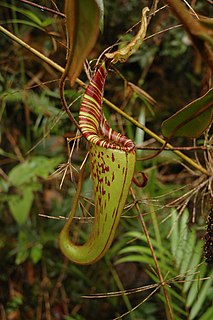
Nepenthes hurrelliana is a tropical pitcher plant endemic to Borneo, where it has been recorded from northern Sarawak, southwestern Sabah, and Brunei. It is of putative hybrid origin; its two original parent species are thought to be N. fusca and N. veitchii. A thick indumentum of rusty-brown hairs covers the entire plant, a characteristic presumably inherited from the latter.

Callidulidae, the only known family of the superfamily Calliduloidea, is the family of Old World butterfly-moths, containing eight genera. They have a peculiar distribution, restricted to the Old World tropics of South East Asia to Australasia and Madagascar. The three subfamilies exhibit both day- and night-flying behaviour.
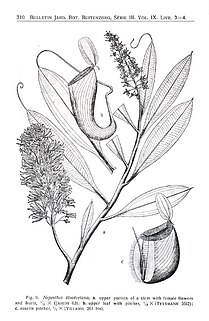
"The Nepenthaceae of the Netherlands Indies" is a seminal monograph by B. H. Danser on the tropical pitcher plants of the Dutch East Indies and surrounding regions. It was originally published in the Bulletin du Jardin Botanique de Buitenzorg in 1928, and reprinted by Natural History Publications (Borneo) in 2006.
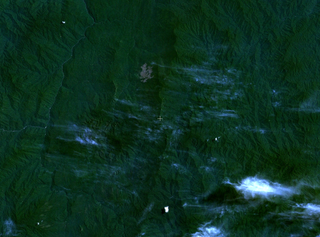
Mount Kemul is a mountain in East Kalimantan. It is the type locality of the pitcher plant species Nepenthes fusca and Nepenthes mollis.

Nudaria is a genus of moths in the subfamily Arctiinae first described by Adrian Hardy Haworth in 1809.
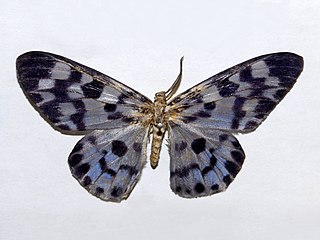
Longicella is a genus of moths of the family Noctuidae.
Myrioblephara is a genus of moths in the family Geometridae first described by Warren in 1893.

Thyas honesta is a species of moth of the family Noctuidae first described by Jacob Hübner in 1824. It is found in the Indian subregion, Myanmar, Thailand, Peninsular Malaysia, Sumatra, Sri Lanka, Borneo and on the Philippines.

Ercheia cyllaria is a species of moth of the family Erebidae first described by Pieter Cramer in 1779. It is found in the Indian subregion, Sri Lanka, Taiwan, Japan, Indochina, Thailand, Peninsular Malaysia, Sumatra, Borneo, Seram and the Kai Islands.

Trigonodes hyppasia, the triangles or semi-looper, is a moth in the family Erebidae. The species was first described by Pieter Cramer in 1779. It is largely cosmopolitan, found throughout Borneo, Fiji, India, Nepal, Sri Lanka, São Tomé and Príncipe, Taiwan, Zimbabwe, northern Australia, and almost all African countries.

Leucania loreyi, the cosmopolitan, false army worm or nightfeeding rice armyworm, is a species of moth of the family Noctuidae. It is found in most of African countries, the Indo-Australian subtropics and tropics of India, Sri Lanka, Myanmar, the eastern Palearctic ecozone and the Near East and Middle East. The species was first described by Philogène Auguste Joseph Duponchel in 1827.
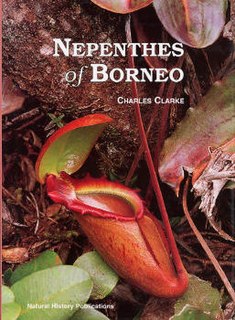
Nepenthes of Borneo is a monograph by Charles Clarke on the tropical pitcher plants of Borneo. It was first published in 1997 by Natural History Publications (Borneo), and reprinted in 2006. Clarke describes it as "primarily an ecological monograph".

Pitcher-Plants of Borneo is a monograph by Anthea Phillipps and Anthony Lamb on the tropical pitcher plants of Borneo. It was first published in 1996 by Natural History Publications (Borneo), in association with the Royal Botanic Gardens, Kew and the Malaysian Nature Society. An updated and much expanded second edition was published in 2008 as Pitcher Plants of Borneo, with Ch'ien Lee as co-author.

Anticarsia irrorata, the owl moth, is a species of moth in the family Noctuidae. It is native to the Old World tropics.
Abaciscus intractabilis is a species of moth belonging to the family Geometridae. It was described by Francis Walker in 1864. It is known from Borneo, Peninsular Malaysia and Sumatra.
Theretra insularis is a moth of the family Sphingidae. It is known from the Philippines, north-eastern Borneo, the Moluccas, Papua New Guinea, the Solomon Islands and Fiji.
Mnesiloba intentata is a moth of the family Geometridae first described by Francis Walker in 1866. It is known from Borneo, Java, Peninsular Malaysia, Luzon and New Guinea. The species was cited by George Hampson that, it is also found in Sri Lanka, but recent observations from the country reject the presence of the species from Sri Lanka.
Nagia linteola is a species of moth in the family Erebidae first described by Achille Guenée in 1852. This species occurs in South Africa, the Democratic Republic of the Congo, Yemen, the Comoros, Mauritius, Madagascar, Indonesia (Borneo), India, Sri Lanka, Myanmar, Thailand and in Australia, where it has been recorded from Western Australia, the Northern Territory, Queensland and Victoria.



















